That is a typical small product of Thanh Le company, a famous high-end handicraft manufacturing company in the South for more than 30 years before 1975. This is the most successful company in the field of manufacturing and trading interior decoration products, sold on the two most luxurious streets in Saigon at that time, Tu Do (now Dong Khoi) and Han Thuyen. The company's reputation went beyond the borders of Vietnam during the division period. According to the October 1972 issue of the Enterprise Management Monthly published in Saigon, up to that time, Thanh Le company had the following achievements: Gold Medal at the Munich International Fair 1964 - Silver Medal awarded by the Ministry of Economy (South Vietnam) in 1968 - Honorary Certificate at the Paris Fair 1969 - Medal and Honorary Certificate at the Paris Fair 1970 - Gold Medal at the Saigon Agricultural, Industrial and Commercial Fair 1970. 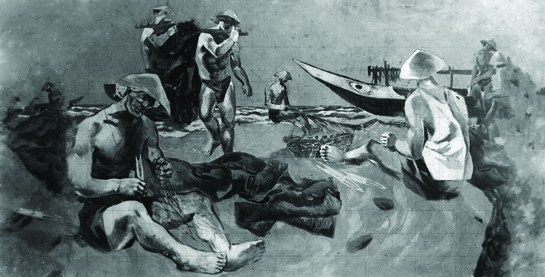 Lacquer painting sample drawing by artist Thai Van Ngon.
Lacquer painting sample drawing by artist Thai Van Ngon. 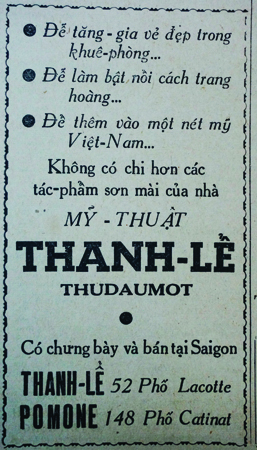 Newspaper advertisement for Thanh and Le companies of Mr. Truong Van Thanh and Mr. Nguyen Thanh Le before they split into two companies.
Newspaper advertisement for Thanh and Le companies of Mr. Truong Van Thanh and Mr. Nguyen Thanh Le before they split into two companies. 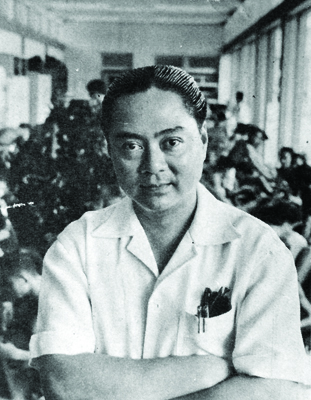 Portrait of Mr. Nguyen Thanh Le
Portrait of Mr. Nguyen Thanh Le 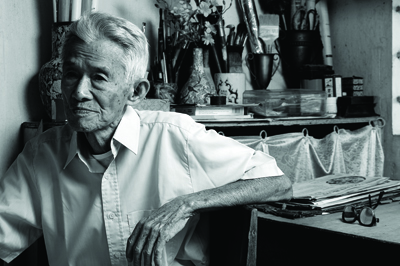 Painter Nguyen Van Tuyen. Photo: Duc Tri
Painter Nguyen Van Tuyen. Photo: Duc Tri 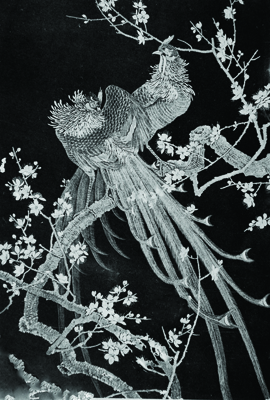 A popular model of Thanh Le lacquer In addition, Thanh Le products have participated in lacquer exhibitions in France (1952), Thailand (1954), the Philippines (1956) and the United States (1959). Up to now, overseas Vietnamese, especially from France and art lovers in the country still seek to buy Thanh Le products. They display them in their homes to find the peaceful and prosperous atmosphere of the former Saigon city. The middle class and above of Saigon and the provinces who can buy Thanh Le lacquer paintings, elephant pedestals, Thanh Le ceramic vases or Thanh Le wool carpets feel that they are enough to create a luxurious look for their villa or townhouse. However, speaking specifically about the fine art lacquer paintings which are the main products of Thanh Le, it is necessary to distinguish two types. One type is widely sold in showrooms with the logo of Thanh Le and the other type is high-end paintings, made according to orders from domestic and foreign customers. According to artist Pham Cung (who once assisted artist Duy Liem, the main artist who designed paintings for Thanh Le company), high-end paintings are identified by a logo painted on the back of the painting with a dragon, below which is the word Thanh Le lying horizontally and plated in 4-carat gold. The above awards belong to this high-end painting. One afternoon in late 2008, we were lucky to meet again the old artist Nguyen Van Tuyen, often called Uncle Ba Tuyen in Binh Duong , the hometown of Thanh Le company. Born in 1924, he is probably the rare artist who worked the longest for Thanh Le (from 1943 to 1975) and is still alive. The artists who worked for the company were Mr. Hai Su, Chau Van Tri, Ba Ai, Bay Day, Nam Chau (sculpture), Nguyen Tan Tam, Nguyen Van Tam, Thai Van Ngon, Duy Liem, Tran Van Nam, Tran Van Sau (lacquer painting), Ngo Tu Sam (silk painting), Van Thoat, Luong Dinh Tanh (painting tables and chairs), artisans Bay Giap, Sau Mien, Hai Long (mother-of-pearl inlay), Sau Sa (ceramic painting)... most of whom have passed away.
A popular model of Thanh Le lacquer In addition, Thanh Le products have participated in lacquer exhibitions in France (1952), Thailand (1954), the Philippines (1956) and the United States (1959). Up to now, overseas Vietnamese, especially from France and art lovers in the country still seek to buy Thanh Le products. They display them in their homes to find the peaceful and prosperous atmosphere of the former Saigon city. The middle class and above of Saigon and the provinces who can buy Thanh Le lacquer paintings, elephant pedestals, Thanh Le ceramic vases or Thanh Le wool carpets feel that they are enough to create a luxurious look for their villa or townhouse. However, speaking specifically about the fine art lacquer paintings which are the main products of Thanh Le, it is necessary to distinguish two types. One type is widely sold in showrooms with the logo of Thanh Le and the other type is high-end paintings, made according to orders from domestic and foreign customers. According to artist Pham Cung (who once assisted artist Duy Liem, the main artist who designed paintings for Thanh Le company), high-end paintings are identified by a logo painted on the back of the painting with a dragon, below which is the word Thanh Le lying horizontally and plated in 4-carat gold. The above awards belong to this high-end painting. One afternoon in late 2008, we were lucky to meet again the old artist Nguyen Van Tuyen, often called Uncle Ba Tuyen in Binh Duong , the hometown of Thanh Le company. Born in 1924, he is probably the rare artist who worked the longest for Thanh Le (from 1943 to 1975) and is still alive. The artists who worked for the company were Mr. Hai Su, Chau Van Tri, Ba Ai, Bay Day, Nam Chau (sculpture), Nguyen Tan Tam, Nguyen Van Tam, Thai Van Ngon, Duy Liem, Tran Van Nam, Tran Van Sau (lacquer painting), Ngo Tu Sam (silk painting), Van Thoat, Luong Dinh Tanh (painting tables and chairs), artisans Bay Giap, Sau Mien, Hai Long (mother-of-pearl inlay), Sau Sa (ceramic painting)... most of whom have passed away.  Thanh Le handicraft products.
Thanh Le handicraft products. 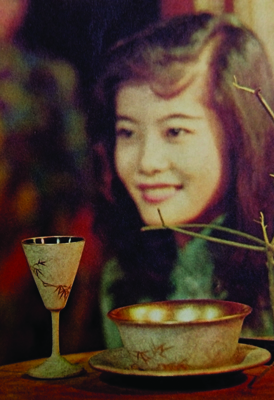 Thanh Le lacquerware in the 1962 "Vietnam Technology" calendar.
Thanh Le lacquerware in the 1962 "Vietnam Technology" calendar. 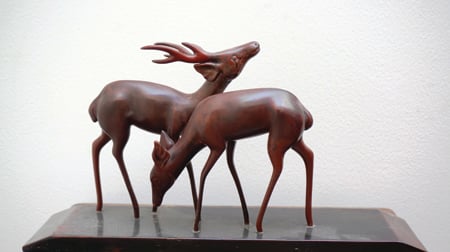 Thanh Le handicraft products.
Thanh Le handicraft products. 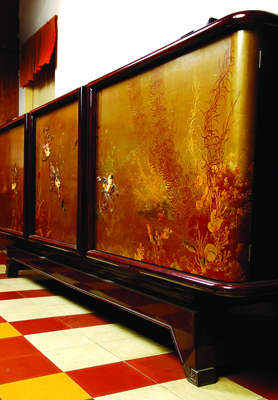 Thanh Le handicraft products. According to Mr. Ba Tuyen, the predecessor of Thanh Le was the workshop "Thanh & Le" founded by Mr. Truong Van Thanh and Mr. Nguyen Thanh Le in 1940. In the early 60s, Mr. Nguyen Thanh Le separated and established Thanh Le workshop. From there, a production and business process began that was enough to build an indelible name. Mr. Tuyen remembers that painter Thanh Le was born in 1919 in Long Xuyen, specialized in lacquer and carving, graduated from Thu Dau Mot Fine Arts School around 1940 (some documents say in 1938), two classes before Mr. Tuyen. When separated, Thanh Le lacquer workshop located in Binh Duong had 12 painters, 2 pattern makers, 20 carpenters, 60 lacquer specialists, 4 carvers, and 1 mother-of-pearl inlay worker. Thanh Le production workshop was built on a fairly large scale in Binh Duong. Next to the workshop is a beautifully decorated showroom. Here, a variety of products are displayed, from large screens, with rich themes from historical themes such as Hai Ba Trung defeating the Han army, the battle of Dong Da, Bach Dang Giang, the stories of Kim Van Kieu, Luc Van Tien, beautiful Vietnamese landscapes such as Huong River and Ngu Mountain, Thien Mu Pagoda, Cham Towers, rural life scenes and images of farmers, images of flowers, birds, etc. In addition, there are other products such as highly artistic lacquered household items such as vases, tables, chairs, cabinets and other decorative items.
Thanh Le handicraft products. According to Mr. Ba Tuyen, the predecessor of Thanh Le was the workshop "Thanh & Le" founded by Mr. Truong Van Thanh and Mr. Nguyen Thanh Le in 1940. In the early 60s, Mr. Nguyen Thanh Le separated and established Thanh Le workshop. From there, a production and business process began that was enough to build an indelible name. Mr. Tuyen remembers that painter Thanh Le was born in 1919 in Long Xuyen, specialized in lacquer and carving, graduated from Thu Dau Mot Fine Arts School around 1940 (some documents say in 1938), two classes before Mr. Tuyen. When separated, Thanh Le lacquer workshop located in Binh Duong had 12 painters, 2 pattern makers, 20 carpenters, 60 lacquer specialists, 4 carvers, and 1 mother-of-pearl inlay worker. Thanh Le production workshop was built on a fairly large scale in Binh Duong. Next to the workshop is a beautifully decorated showroom. Here, a variety of products are displayed, from large screens, with rich themes from historical themes such as Hai Ba Trung defeating the Han army, the battle of Dong Da, Bach Dang Giang, the stories of Kim Van Kieu, Luc Van Tien, beautiful Vietnamese landscapes such as Huong River and Ngu Mountain, Thien Mu Pagoda, Cham Towers, rural life scenes and images of farmers, images of flowers, birds, etc. In addition, there are other products such as highly artistic lacquered household items such as vases, tables, chairs, cabinets and other decorative items.  Thanh Le products and staff at the store.
Thanh Le products and staff at the store. 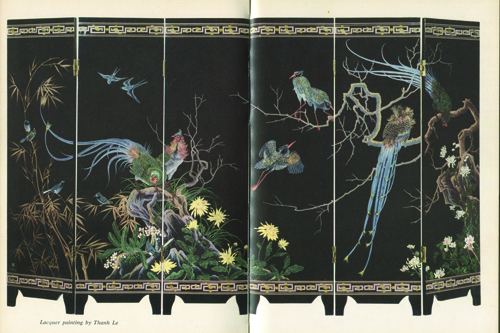 Lacquer screen by Thanh Le printed in the book Vietnam, where East & West meet. Author: Do Van Minh-Edizione Quattro Venti, Rome published 1962.
Lacquer screen by Thanh Le printed in the book Vietnam, where East & West meet. Author: Do Van Minh-Edizione Quattro Venti, Rome published 1962. 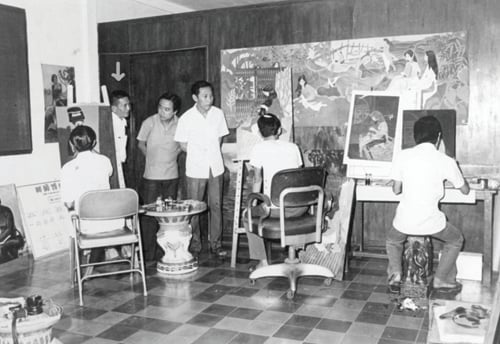 In the lacquer workshop of Thanh Le company. The person under the arrow is painter Duy Liem, the famous model painter of the company. Photo: Painter Duy Liem's family.
In the lacquer workshop of Thanh Le company. The person under the arrow is painter Duy Liem, the famous model painter of the company. Photo: Painter Duy Liem's family. 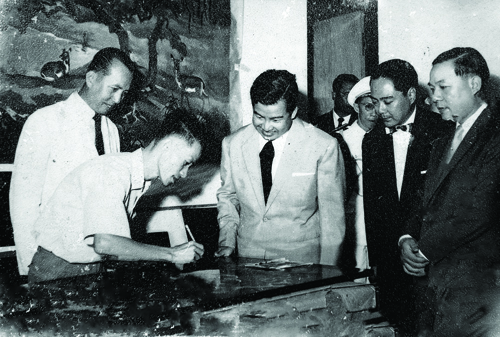 Prince Sihanouk of Cambodia visited Thanh Le Company in the early 1960s and watched artist Ba Tuyen paint lacquer paintings. On the left is artist Luu Dinh Khai, principal of Gia Dinh Fine Arts School.
Prince Sihanouk of Cambodia visited Thanh Le Company in the early 1960s and watched artist Ba Tuyen paint lacquer paintings. On the left is artist Luu Dinh Khai, principal of Gia Dinh Fine Arts School. 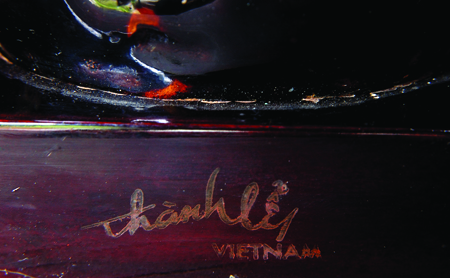 Company logo. In 1962, Thanh Le opened a wool carpet weaving workshop and merged the facilities into Thanh Le lacquerware workshop - pottery kiln - wool carpet. From a few dozen workers at first, the workshop later had up to 500 workers. Mr. Tuyen said that since then, Thanh Le has organized business and marketing very systematically. Mr. Thanh Le is good at organizing, has professional talent and knows how to attract many talented people from places such as Gia Dinh Fine Arts School, Bien Hoa Fine Arts and Binh Duong Fine Arts. Many of the painters under his direction are talented, having won prestigious painting awards. Thanh Le workshop has created many beautiful designs with high artistic value. Many designs are only used once for a work, so they have high artistic value and are unique products. According to documents, Mr. Thanh Le really hates stereotyped designs, always requiring painters not to imitate existing designs but to continuously innovate until they reach artistic value before putting them into production. In return, he has a high salary and bonus system, so the artists make him live comfortably on his salary. Painter Ba Tuyen alone, during more than thirty years of working, can comfortably support seven relatives including his parents, wife and four children who are studying. Mr. Thanh Le often goes abroad to research and collect designs to meet the tastes of customers, especially European customers. In the process of development orientation, he focuses on producing works of high artistic value, combining the arts of sculpting, decoration, painting and sculpture. The colors of the products focus on aesthetic value, elegance and beauty, many fine art products reach high artistic value.
Company logo. In 1962, Thanh Le opened a wool carpet weaving workshop and merged the facilities into Thanh Le lacquerware workshop - pottery kiln - wool carpet. From a few dozen workers at first, the workshop later had up to 500 workers. Mr. Tuyen said that since then, Thanh Le has organized business and marketing very systematically. Mr. Thanh Le is good at organizing, has professional talent and knows how to attract many talented people from places such as Gia Dinh Fine Arts School, Bien Hoa Fine Arts and Binh Duong Fine Arts. Many of the painters under his direction are talented, having won prestigious painting awards. Thanh Le workshop has created many beautiful designs with high artistic value. Many designs are only used once for a work, so they have high artistic value and are unique products. According to documents, Mr. Thanh Le really hates stereotyped designs, always requiring painters not to imitate existing designs but to continuously innovate until they reach artistic value before putting them into production. In return, he has a high salary and bonus system, so the artists make him live comfortably on his salary. Painter Ba Tuyen alone, during more than thirty years of working, can comfortably support seven relatives including his parents, wife and four children who are studying. Mr. Thanh Le often goes abroad to research and collect designs to meet the tastes of customers, especially European customers. In the process of development orientation, he focuses on producing works of high artistic value, combining the arts of sculpting, decoration, painting and sculpture. The colors of the products focus on aesthetic value, elegance and beauty, many fine art products reach high artistic value.  THANH LE – Hair stream. Lacquer. 95x56cm. Collected by Pham Hoang Viet
THANH LE – Hair stream. Lacquer. 95x56cm. Collected by Pham Hoang Viet 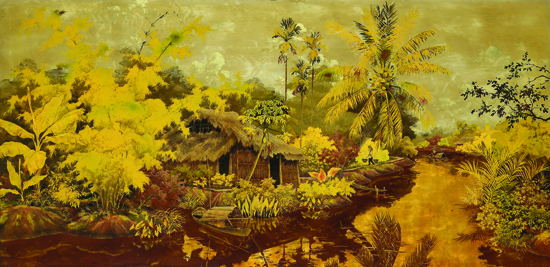 Thanh Le – By the Mekong River. About 1950. Lacquer. 61x126cm. Collected by Ngo Kim Khoi
Thanh Le – By the Mekong River. About 1950. Lacquer. 61x126cm. Collected by Ngo Kim Khoi 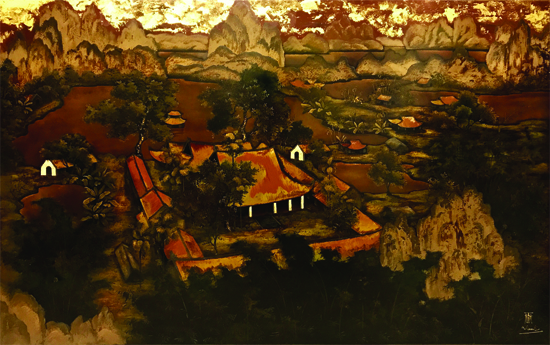 TRUONG VAN THANH – Chua Thay. Around 1950. Lacquer. 50x80cm. Private collection, Hanoi Thanks to participating in many international fairs and continuously winning awards, his products have created a good reputation. However, he does not pursue profit but always emphasizes quality. In the main lacquer products, he uses the best materials such as imported En Kounmé plywood, Teak (Gia Ti) or Go Do, Boi Loi wood panels. In lacquer, the main material is Nam Vang lacquer with its own gloss and beautiful color. If the products displayed at international fairs are ordered, he does not rush to deliver them but waits six months after leaving the factory to deliver them, after monitoring the quality of the painting or item to see if it is deformed by the weather in a foreign country. In general, he does not care about output but only cares about quality, does not assign products to achieve high productivity but only cares about whether the product is beautiful enough. Perhaps that is why the products here are always more expensive than other establishments but still in high demand. Also according to the article in the monthly magazine Quan tri xiep nghiep, not counting domestic revenue, by 1972 Thanh Le exported each year with a turnover of 100,000 USD, a significant number at that time (the price of a tael of gold at that time was 200 USD), the products were mainly exported to France and West Germany. At that time, the Company's products were still more expensive than similar products from Japan or Taiwan because of their high quality, completely handmade and using the best materials from abroad. The export potential was very good, but Mr. Thanh Le had to refuse many orders because the most important problem was the lack of workers due to the conscription situation at that time. However, he aimed to open the market to the United States, building a factory in Bien Hoa industrial park with 2,000 employees. This plan was stalled since Tet Mau Than and did not succeed because Thanh Le stopped operating in 1975. The most luxurious buildings in Saigon before 1975 all had Thanh Le's works, such as the Gia Long Palace dining room with lacquer paintings, and the Caravelle Hotel also had Thanh Le's paintings. According to Uncle Ba Tuyen's memory, in 1966, the Independence Palace was inaugurated, in addition to the presence of two paintings by artist Thai Van Ngon, who was from Thanh Le, there was also a 40-meter-long wool carpet from Thanh Le's workshop that had to be carried by more than 40 people, and when it was delivered, a long trailer was needed to load it. The famous Majestic Hotel also had a carved sliding door named "Old Wedding". In addition, many international guests when coming to Saigon were introduced to visit Thanh Le's workshop. Uncle Ba Tuyen still keeps a photo of Prince Sihanouk (Cambodia) visiting the workshop and placing an order in the 60s, as a memory of his working life. According to artist Pham Cung, who worked as a modeler at Thanh Le Company in the past, in the early 1960s, Japan ordered three thousand lacquer paintings of various sizes about Phan Boi Chau, the initiator of the Dong Du movement in the early 20th century. After completing a number of paintings, artist Pham Cung found a picture of Phan leaning on a cane during the "Old Man Ben Ngu" period at the end of his life in Hue. The painting was tested on one piece and when the Japanese saw it, they decided to change the old design and continue making the remaining paintings from this model. Mr. Cung recalled that the paintings were made entirely of oil wood, not plywood as usual, the largest size was 80x120cm. Through that, we can imagine the role of Phan in the Japanese consciousness.
TRUONG VAN THANH – Chua Thay. Around 1950. Lacquer. 50x80cm. Private collection, Hanoi Thanks to participating in many international fairs and continuously winning awards, his products have created a good reputation. However, he does not pursue profit but always emphasizes quality. In the main lacquer products, he uses the best materials such as imported En Kounmé plywood, Teak (Gia Ti) or Go Do, Boi Loi wood panels. In lacquer, the main material is Nam Vang lacquer with its own gloss and beautiful color. If the products displayed at international fairs are ordered, he does not rush to deliver them but waits six months after leaving the factory to deliver them, after monitoring the quality of the painting or item to see if it is deformed by the weather in a foreign country. In general, he does not care about output but only cares about quality, does not assign products to achieve high productivity but only cares about whether the product is beautiful enough. Perhaps that is why the products here are always more expensive than other establishments but still in high demand. Also according to the article in the monthly magazine Quan tri xiep nghiep, not counting domestic revenue, by 1972 Thanh Le exported each year with a turnover of 100,000 USD, a significant number at that time (the price of a tael of gold at that time was 200 USD), the products were mainly exported to France and West Germany. At that time, the Company's products were still more expensive than similar products from Japan or Taiwan because of their high quality, completely handmade and using the best materials from abroad. The export potential was very good, but Mr. Thanh Le had to refuse many orders because the most important problem was the lack of workers due to the conscription situation at that time. However, he aimed to open the market to the United States, building a factory in Bien Hoa industrial park with 2,000 employees. This plan was stalled since Tet Mau Than and did not succeed because Thanh Le stopped operating in 1975. The most luxurious buildings in Saigon before 1975 all had Thanh Le's works, such as the Gia Long Palace dining room with lacquer paintings, and the Caravelle Hotel also had Thanh Le's paintings. According to Uncle Ba Tuyen's memory, in 1966, the Independence Palace was inaugurated, in addition to the presence of two paintings by artist Thai Van Ngon, who was from Thanh Le, there was also a 40-meter-long wool carpet from Thanh Le's workshop that had to be carried by more than 40 people, and when it was delivered, a long trailer was needed to load it. The famous Majestic Hotel also had a carved sliding door named "Old Wedding". In addition, many international guests when coming to Saigon were introduced to visit Thanh Le's workshop. Uncle Ba Tuyen still keeps a photo of Prince Sihanouk (Cambodia) visiting the workshop and placing an order in the 60s, as a memory of his working life. According to artist Pham Cung, who worked as a modeler at Thanh Le Company in the past, in the early 1960s, Japan ordered three thousand lacquer paintings of various sizes about Phan Boi Chau, the initiator of the Dong Du movement in the early 20th century. After completing a number of paintings, artist Pham Cung found a picture of Phan leaning on a cane during the "Old Man Ben Ngu" period at the end of his life in Hue. The painting was tested on one piece and when the Japanese saw it, they decided to change the old design and continue making the remaining paintings from this model. Mr. Cung recalled that the paintings were made entirely of oil wood, not plywood as usual, the largest size was 80x120cm. Through that, we can imagine the role of Phan in the Japanese consciousness. 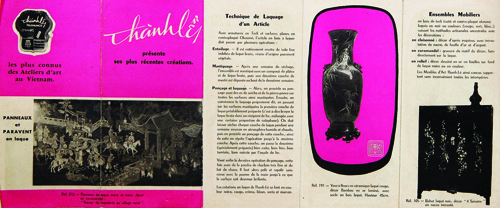 Company brochure in French.
Company brochure in French.  Ceramic vases and Thanh Le lacquer statues decorate the house of Mr. Tran Cong Vang in Thu Dau Mot, Binh Duong. Photo: Duc Tri
Ceramic vases and Thanh Le lacquer statues decorate the house of Mr. Tran Cong Vang in Thu Dau Mot, Binh Duong. Photo: Duc Tri 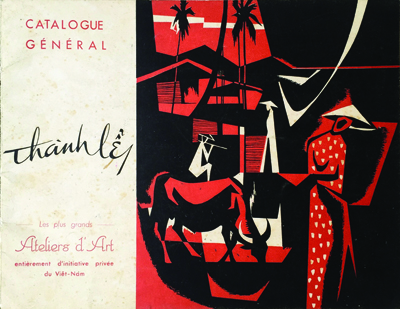 Catagoge After 1975, Mr. Thanh Le and his family moved to France, the country that accepted him into the National Fine Arts Association. In an article on the website Hon Que, author Bich Xuan said, “Thanh Le’s lacquer works were hung in residences such as the private residence of US President Richard Nixon, the private residence of King Hassan II in Ifrane (Morocco), the castle of French President Charles de Gaulle in Colombey les II Eglises (La Boissery), OMS (Organisation Mondiale de la Santé) in Switzerland…” More than thirty years have passed, although its value has been affirmed for more than half a century, Thanh Le’s name still seems to have not overcome the view that fine art is overlooked, no matter what level of art it has reached. In 1960, Saigon organized the first International Fine Arts Exhibition. Besides the works of famous artists, Thanh Le Company's lacquer works were also invited to be exhibited. Afterwards, there was a critical article in Bach Khoa magazine, issue 141, published on January 15, 1962. The author thought that Thanh Le's lacquer works were out of place and "should probably be reserved for separate exhibitions on small technological items". No reason was given. In 2009, in the book Modern Vietnamese Plastic Arts summarizing the process of several decades of following Southern fine arts before and after 1975, when talking about Vietnamese lacquer art, after mentioning the achievements of young artists of the Indochina College of Fine Arts in bringing lacquer into painting, raising the role of a precious material that had previously only stopped at the level of fine arts to a respectable position in the fine arts life at home and abroad in the period 1930-1932, author Huynh Huu Uy wrote: “Some people of Southern origin who graduated from the Hanoi College of Fine Arts such as painter Nguyen Van Long brought back to popularize these new results at the Thu Dau Mot Fine Arts School... ... The lacquer industry developed widely, the people of Thu Dau Mot town and neighboring areas mostly specialized in making a living from lacquer. From small household handicrafts, it has grown larger and larger, producing many items of high economic value such as cabinets, tables, screens, and decorative paintings that have attracted attention in many places, appearing in many places. exported to Western Europe, North Africa, the Middle East, America... won many gold medals at international fairs. The great success of Thanh Le Fine Arts Workshop in the past is a typical evidence, although located right in the center of Saigon, it is actually based in Thu Dau Mot area, most of the products are made by lacquer artists of Thu Dau Mot Fine Arts School, or if not, they are workers who have more or less connections or are under the influence of this school. With that development, the new generation of talented, passionate, energetic lacquer artists has brought lacquer art to the highest glory of a unique artistic style, very mysterious, magical, profound, seemingly unrealistic but completely close to human life, reflecting reality with its own rules of distilling the essence". That is the affirmation of the value of lacquer art in the art field of which Thanh Le is the leading bird. However, until now, there have been very few official documents, films, and exhibitions in the country that have officially recognized the artistic value or business talent of Thanh Le, a brand whose stature has gone beyond the borders of a country at war. However, in the hearts of Southern art lovers, the name Thanh Le still resonates as a memory, a golden past. And certainly, a respectful affection for the line of products of this famous art studio that has passed away still exists quietly.
Catagoge After 1975, Mr. Thanh Le and his family moved to France, the country that accepted him into the National Fine Arts Association. In an article on the website Hon Que, author Bich Xuan said, “Thanh Le’s lacquer works were hung in residences such as the private residence of US President Richard Nixon, the private residence of King Hassan II in Ifrane (Morocco), the castle of French President Charles de Gaulle in Colombey les II Eglises (La Boissery), OMS (Organisation Mondiale de la Santé) in Switzerland…” More than thirty years have passed, although its value has been affirmed for more than half a century, Thanh Le’s name still seems to have not overcome the view that fine art is overlooked, no matter what level of art it has reached. In 1960, Saigon organized the first International Fine Arts Exhibition. Besides the works of famous artists, Thanh Le Company's lacquer works were also invited to be exhibited. Afterwards, there was a critical article in Bach Khoa magazine, issue 141, published on January 15, 1962. The author thought that Thanh Le's lacquer works were out of place and "should probably be reserved for separate exhibitions on small technological items". No reason was given. In 2009, in the book Modern Vietnamese Plastic Arts summarizing the process of several decades of following Southern fine arts before and after 1975, when talking about Vietnamese lacquer art, after mentioning the achievements of young artists of the Indochina College of Fine Arts in bringing lacquer into painting, raising the role of a precious material that had previously only stopped at the level of fine arts to a respectable position in the fine arts life at home and abroad in the period 1930-1932, author Huynh Huu Uy wrote: “Some people of Southern origin who graduated from the Hanoi College of Fine Arts such as painter Nguyen Van Long brought back to popularize these new results at the Thu Dau Mot Fine Arts School... ... The lacquer industry developed widely, the people of Thu Dau Mot town and neighboring areas mostly specialized in making a living from lacquer. From small household handicrafts, it has grown larger and larger, producing many items of high economic value such as cabinets, tables, screens, and decorative paintings that have attracted attention in many places, appearing in many places. exported to Western Europe, North Africa, the Middle East, America... won many gold medals at international fairs. The great success of Thanh Le Fine Arts Workshop in the past is a typical evidence, although located right in the center of Saigon, it is actually based in Thu Dau Mot area, most of the products are made by lacquer artists of Thu Dau Mot Fine Arts School, or if not, they are workers who have more or less connections or are under the influence of this school. With that development, the new generation of talented, passionate, energetic lacquer artists has brought lacquer art to the highest glory of a unique artistic style, very mysterious, magical, profound, seemingly unrealistic but completely close to human life, reflecting reality with its own rules of distilling the essence". That is the affirmation of the value of lacquer art in the art field of which Thanh Le is the leading bird. However, until now, there have been very few official documents, films, and exhibitions in the country that have officially recognized the artistic value or business talent of Thanh Le, a brand whose stature has gone beyond the borders of a country at war. However, in the hearts of Southern art lovers, the name Thanh Le still resonates as a memory, a golden past. And certainly, a respectful affection for the line of products of this famous art studio that has passed away still exists quietly.
Source: https://latoa.vn/son-mai-thanh-le,-qua-khu-vang-son-post927.html Lacquer painting sample drawing by artist Thai Van Ngon.
Lacquer painting sample drawing by artist Thai Van Ngon.  Newspaper advertisement for Thanh and Le companies of Mr. Truong Van Thanh and Mr. Nguyen Thanh Le before they split into two companies.
Newspaper advertisement for Thanh and Le companies of Mr. Truong Van Thanh and Mr. Nguyen Thanh Le before they split into two companies.  Portrait of Mr. Nguyen Thanh Le
Portrait of Mr. Nguyen Thanh Le  Painter Nguyen Van Tuyen. Photo: Duc Tri
Painter Nguyen Van Tuyen. Photo: Duc Tri  A popular model of Thanh Le lacquer In addition, Thanh Le products have participated in lacquer exhibitions in France (1952), Thailand (1954), the Philippines (1956) and the United States (1959). Up to now, overseas Vietnamese, especially from France and art lovers in the country still seek to buy Thanh Le products. They display them in their homes to find the peaceful and prosperous atmosphere of the former Saigon city. The middle class and above of Saigon and the provinces who can buy Thanh Le lacquer paintings, elephant pedestals, Thanh Le ceramic vases or Thanh Le wool carpets feel that they are enough to create a luxurious look for their villa or townhouse. However, speaking specifically about the fine art lacquer paintings which are the main products of Thanh Le, it is necessary to distinguish two types. One type is widely sold in showrooms with the logo of Thanh Le and the other type is high-end paintings, made according to orders from domestic and foreign customers. According to artist Pham Cung (who once assisted artist Duy Liem, the main artist who designed paintings for Thanh Le company), high-end paintings are identified by a logo painted on the back of the painting with a dragon, below which is the word Thanh Le lying horizontally and plated in 4-carat gold. The above awards belong to this high-end painting. One afternoon in late 2008, we were lucky to meet again the old artist Nguyen Van Tuyen, often called Uncle Ba Tuyen in Binh Duong , the hometown of Thanh Le company. Born in 1924, he is probably the rare artist who worked the longest for Thanh Le (from 1943 to 1975) and is still alive. The artists who worked for the company were Mr. Hai Su, Chau Van Tri, Ba Ai, Bay Day, Nam Chau (sculpture), Nguyen Tan Tam, Nguyen Van Tam, Thai Van Ngon, Duy Liem, Tran Van Nam, Tran Van Sau (lacquer painting), Ngo Tu Sam (silk painting), Van Thoat, Luong Dinh Tanh (painting tables and chairs), artisans Bay Giap, Sau Mien, Hai Long (mother-of-pearl inlay), Sau Sa (ceramic painting)... most of whom have passed away.
A popular model of Thanh Le lacquer In addition, Thanh Le products have participated in lacquer exhibitions in France (1952), Thailand (1954), the Philippines (1956) and the United States (1959). Up to now, overseas Vietnamese, especially from France and art lovers in the country still seek to buy Thanh Le products. They display them in their homes to find the peaceful and prosperous atmosphere of the former Saigon city. The middle class and above of Saigon and the provinces who can buy Thanh Le lacquer paintings, elephant pedestals, Thanh Le ceramic vases or Thanh Le wool carpets feel that they are enough to create a luxurious look for their villa or townhouse. However, speaking specifically about the fine art lacquer paintings which are the main products of Thanh Le, it is necessary to distinguish two types. One type is widely sold in showrooms with the logo of Thanh Le and the other type is high-end paintings, made according to orders from domestic and foreign customers. According to artist Pham Cung (who once assisted artist Duy Liem, the main artist who designed paintings for Thanh Le company), high-end paintings are identified by a logo painted on the back of the painting with a dragon, below which is the word Thanh Le lying horizontally and plated in 4-carat gold. The above awards belong to this high-end painting. One afternoon in late 2008, we were lucky to meet again the old artist Nguyen Van Tuyen, often called Uncle Ba Tuyen in Binh Duong , the hometown of Thanh Le company. Born in 1924, he is probably the rare artist who worked the longest for Thanh Le (from 1943 to 1975) and is still alive. The artists who worked for the company were Mr. Hai Su, Chau Van Tri, Ba Ai, Bay Day, Nam Chau (sculpture), Nguyen Tan Tam, Nguyen Van Tam, Thai Van Ngon, Duy Liem, Tran Van Nam, Tran Van Sau (lacquer painting), Ngo Tu Sam (silk painting), Van Thoat, Luong Dinh Tanh (painting tables and chairs), artisans Bay Giap, Sau Mien, Hai Long (mother-of-pearl inlay), Sau Sa (ceramic painting)... most of whom have passed away.  Thanh Le handicraft products.
Thanh Le handicraft products.  Thanh Le lacquerware in the 1962 "Vietnam Technology" calendar.
Thanh Le lacquerware in the 1962 "Vietnam Technology" calendar.  Thanh Le handicraft products.
Thanh Le handicraft products.  Thanh Le handicraft products. According to Mr. Ba Tuyen, the predecessor of Thanh Le was the workshop "Thanh & Le" founded by Mr. Truong Van Thanh and Mr. Nguyen Thanh Le in 1940. In the early 60s, Mr. Nguyen Thanh Le separated and established Thanh Le workshop. From there, a production and business process began that was enough to build an indelible name. Mr. Tuyen remembers that painter Thanh Le was born in 1919 in Long Xuyen, specialized in lacquer and carving, graduated from Thu Dau Mot Fine Arts School around 1940 (some documents say in 1938), two classes before Mr. Tuyen. When separated, Thanh Le lacquer workshop located in Binh Duong had 12 painters, 2 pattern makers, 20 carpenters, 60 lacquer specialists, 4 carvers, and 1 mother-of-pearl inlay worker. Thanh Le production workshop was built on a fairly large scale in Binh Duong. Next to the workshop is a beautifully decorated showroom. Here, a variety of products are displayed, from large screens, with rich themes from historical themes such as Hai Ba Trung defeating the Han army, the battle of Dong Da, Bach Dang Giang, the stories of Kim Van Kieu, Luc Van Tien, beautiful Vietnamese landscapes such as Huong River and Ngu Mountain, Thien Mu Pagoda, Cham Towers, rural life scenes and images of farmers, images of flowers, birds, etc. In addition, there are other products such as highly artistic lacquered household items such as vases, tables, chairs, cabinets and other decorative items.
Thanh Le handicraft products. According to Mr. Ba Tuyen, the predecessor of Thanh Le was the workshop "Thanh & Le" founded by Mr. Truong Van Thanh and Mr. Nguyen Thanh Le in 1940. In the early 60s, Mr. Nguyen Thanh Le separated and established Thanh Le workshop. From there, a production and business process began that was enough to build an indelible name. Mr. Tuyen remembers that painter Thanh Le was born in 1919 in Long Xuyen, specialized in lacquer and carving, graduated from Thu Dau Mot Fine Arts School around 1940 (some documents say in 1938), two classes before Mr. Tuyen. When separated, Thanh Le lacquer workshop located in Binh Duong had 12 painters, 2 pattern makers, 20 carpenters, 60 lacquer specialists, 4 carvers, and 1 mother-of-pearl inlay worker. Thanh Le production workshop was built on a fairly large scale in Binh Duong. Next to the workshop is a beautifully decorated showroom. Here, a variety of products are displayed, from large screens, with rich themes from historical themes such as Hai Ba Trung defeating the Han army, the battle of Dong Da, Bach Dang Giang, the stories of Kim Van Kieu, Luc Van Tien, beautiful Vietnamese landscapes such as Huong River and Ngu Mountain, Thien Mu Pagoda, Cham Towers, rural life scenes and images of farmers, images of flowers, birds, etc. In addition, there are other products such as highly artistic lacquered household items such as vases, tables, chairs, cabinets and other decorative items.  Thanh Le products and staff at the store.
Thanh Le products and staff at the store.  Lacquer screen by Thanh Le printed in the book Vietnam, where East & West meet. Author: Do Van Minh-Edizione Quattro Venti, Rome published 1962.
Lacquer screen by Thanh Le printed in the book Vietnam, where East & West meet. Author: Do Van Minh-Edizione Quattro Venti, Rome published 1962.  In the lacquer workshop of Thanh Le company. The person under the arrow is painter Duy Liem, the famous model painter of the company. Photo: Painter Duy Liem's family.
In the lacquer workshop of Thanh Le company. The person under the arrow is painter Duy Liem, the famous model painter of the company. Photo: Painter Duy Liem's family.  Prince Sihanouk of Cambodia visited Thanh Le Company in the early 1960s and watched artist Ba Tuyen paint lacquer paintings. On the left is artist Luu Dinh Khai, principal of Gia Dinh Fine Arts School.
Prince Sihanouk of Cambodia visited Thanh Le Company in the early 1960s and watched artist Ba Tuyen paint lacquer paintings. On the left is artist Luu Dinh Khai, principal of Gia Dinh Fine Arts School.  Company logo. In 1962, Thanh Le opened a wool carpet weaving workshop and merged the facilities into Thanh Le lacquerware workshop - pottery kiln - wool carpet. From a few dozen workers at first, the workshop later had up to 500 workers. Mr. Tuyen said that since then, Thanh Le has organized business and marketing very systematically. Mr. Thanh Le is good at organizing, has professional talent and knows how to attract many talented people from places such as Gia Dinh Fine Arts School, Bien Hoa Fine Arts and Binh Duong Fine Arts. Many of the painters under his direction are talented, having won prestigious painting awards. Thanh Le workshop has created many beautiful designs with high artistic value. Many designs are only used once for a work, so they have high artistic value and are unique products. According to documents, Mr. Thanh Le really hates stereotyped designs, always requiring painters not to imitate existing designs but to continuously innovate until they reach artistic value before putting them into production. In return, he has a high salary and bonus system, so the artists make him live comfortably on his salary. Painter Ba Tuyen alone, during more than thirty years of working, can comfortably support seven relatives including his parents, wife and four children who are studying. Mr. Thanh Le often goes abroad to research and collect designs to meet the tastes of customers, especially European customers. In the process of development orientation, he focuses on producing works of high artistic value, combining the arts of sculpting, decoration, painting and sculpture. The colors of the products focus on aesthetic value, elegance and beauty, many fine art products reach high artistic value.
Company logo. In 1962, Thanh Le opened a wool carpet weaving workshop and merged the facilities into Thanh Le lacquerware workshop - pottery kiln - wool carpet. From a few dozen workers at first, the workshop later had up to 500 workers. Mr. Tuyen said that since then, Thanh Le has organized business and marketing very systematically. Mr. Thanh Le is good at organizing, has professional talent and knows how to attract many talented people from places such as Gia Dinh Fine Arts School, Bien Hoa Fine Arts and Binh Duong Fine Arts. Many of the painters under his direction are talented, having won prestigious painting awards. Thanh Le workshop has created many beautiful designs with high artistic value. Many designs are only used once for a work, so they have high artistic value and are unique products. According to documents, Mr. Thanh Le really hates stereotyped designs, always requiring painters not to imitate existing designs but to continuously innovate until they reach artistic value before putting them into production. In return, he has a high salary and bonus system, so the artists make him live comfortably on his salary. Painter Ba Tuyen alone, during more than thirty years of working, can comfortably support seven relatives including his parents, wife and four children who are studying. Mr. Thanh Le often goes abroad to research and collect designs to meet the tastes of customers, especially European customers. In the process of development orientation, he focuses on producing works of high artistic value, combining the arts of sculpting, decoration, painting and sculpture. The colors of the products focus on aesthetic value, elegance and beauty, many fine art products reach high artistic value.  THANH LE – Hair stream. Lacquer. 95x56cm. Collected by Pham Hoang Viet
THANH LE – Hair stream. Lacquer. 95x56cm. Collected by Pham Hoang Viet  Thanh Le – By the Mekong River. About 1950. Lacquer. 61x126cm. Collected by Ngo Kim Khoi
Thanh Le – By the Mekong River. About 1950. Lacquer. 61x126cm. Collected by Ngo Kim Khoi  TRUONG VAN THANH – Chua Thay. Around 1950. Lacquer. 50x80cm. Private collection, Hanoi Thanks to participating in many international fairs and continuously winning awards, his products have created a good reputation. However, he does not pursue profit but always emphasizes quality. In the main lacquer products, he uses the best materials such as imported En Kounmé plywood, Teak (Gia Ti) or Go Do, Boi Loi wood panels. In lacquer, the main material is Nam Vang lacquer with its own gloss and beautiful color. If the products displayed at international fairs are ordered, he does not rush to deliver them but waits six months after leaving the factory to deliver them, after monitoring the quality of the painting or item to see if it is deformed by the weather in a foreign country. In general, he does not care about output but only cares about quality, does not assign products to achieve high productivity but only cares about whether the product is beautiful enough. Perhaps that is why the products here are always more expensive than other establishments but still in high demand. Also according to the article in the monthly magazine Quan tri xiep nghiep, not counting domestic revenue, by 1972 Thanh Le exported each year with a turnover of 100,000 USD, a significant number at that time (the price of a tael of gold at that time was 200 USD), the products were mainly exported to France and West Germany. At that time, the Company's products were still more expensive than similar products from Japan or Taiwan because of their high quality, completely handmade and using the best materials from abroad. The export potential was very good, but Mr. Thanh Le had to refuse many orders because the most important problem was the lack of workers due to the conscription situation at that time. However, he aimed to open the market to the United States, building a factory in Bien Hoa industrial park with 2,000 employees. This plan was stalled since Tet Mau Than and did not succeed because Thanh Le stopped operating in 1975. The most luxurious buildings in Saigon before 1975 all had Thanh Le's works, such as the Gia Long Palace dining room with lacquer paintings, and the Caravelle Hotel also had Thanh Le's paintings. According to Uncle Ba Tuyen's memory, in 1966, the Independence Palace was inaugurated, in addition to the presence of two paintings by artist Thai Van Ngon, who was from Thanh Le, there was also a 40-meter-long wool carpet from Thanh Le's workshop that had to be carried by more than 40 people, and when it was delivered, a long trailer was needed to load it. The famous Majestic Hotel also had a carved sliding door named "Old Wedding". In addition, many international guests when coming to Saigon were introduced to visit Thanh Le's workshop. Uncle Ba Tuyen still keeps a photo of Prince Sihanouk (Cambodia) visiting the workshop and placing an order in the 60s, as a memory of his working life. According to artist Pham Cung, who worked as a modeler at Thanh Le Company in the past, in the early 1960s, Japan ordered three thousand lacquer paintings of various sizes about Phan Boi Chau, the initiator of the Dong Du movement in the early 20th century. After completing a number of paintings, artist Pham Cung found a picture of Phan leaning on a cane during the "Old Man Ben Ngu" period at the end of his life in Hue. The painting was tested on one piece and when the Japanese saw it, they decided to change the old design and continue making the remaining paintings from this model. Mr. Cung recalled that the paintings were made entirely of oil wood, not plywood as usual, the largest size was 80x120cm. Through that, we can imagine the role of Phan in the Japanese consciousness.
TRUONG VAN THANH – Chua Thay. Around 1950. Lacquer. 50x80cm. Private collection, Hanoi Thanks to participating in many international fairs and continuously winning awards, his products have created a good reputation. However, he does not pursue profit but always emphasizes quality. In the main lacquer products, he uses the best materials such as imported En Kounmé plywood, Teak (Gia Ti) or Go Do, Boi Loi wood panels. In lacquer, the main material is Nam Vang lacquer with its own gloss and beautiful color. If the products displayed at international fairs are ordered, he does not rush to deliver them but waits six months after leaving the factory to deliver them, after monitoring the quality of the painting or item to see if it is deformed by the weather in a foreign country. In general, he does not care about output but only cares about quality, does not assign products to achieve high productivity but only cares about whether the product is beautiful enough. Perhaps that is why the products here are always more expensive than other establishments but still in high demand. Also according to the article in the monthly magazine Quan tri xiep nghiep, not counting domestic revenue, by 1972 Thanh Le exported each year with a turnover of 100,000 USD, a significant number at that time (the price of a tael of gold at that time was 200 USD), the products were mainly exported to France and West Germany. At that time, the Company's products were still more expensive than similar products from Japan or Taiwan because of their high quality, completely handmade and using the best materials from abroad. The export potential was very good, but Mr. Thanh Le had to refuse many orders because the most important problem was the lack of workers due to the conscription situation at that time. However, he aimed to open the market to the United States, building a factory in Bien Hoa industrial park with 2,000 employees. This plan was stalled since Tet Mau Than and did not succeed because Thanh Le stopped operating in 1975. The most luxurious buildings in Saigon before 1975 all had Thanh Le's works, such as the Gia Long Palace dining room with lacquer paintings, and the Caravelle Hotel also had Thanh Le's paintings. According to Uncle Ba Tuyen's memory, in 1966, the Independence Palace was inaugurated, in addition to the presence of two paintings by artist Thai Van Ngon, who was from Thanh Le, there was also a 40-meter-long wool carpet from Thanh Le's workshop that had to be carried by more than 40 people, and when it was delivered, a long trailer was needed to load it. The famous Majestic Hotel also had a carved sliding door named "Old Wedding". In addition, many international guests when coming to Saigon were introduced to visit Thanh Le's workshop. Uncle Ba Tuyen still keeps a photo of Prince Sihanouk (Cambodia) visiting the workshop and placing an order in the 60s, as a memory of his working life. According to artist Pham Cung, who worked as a modeler at Thanh Le Company in the past, in the early 1960s, Japan ordered three thousand lacquer paintings of various sizes about Phan Boi Chau, the initiator of the Dong Du movement in the early 20th century. After completing a number of paintings, artist Pham Cung found a picture of Phan leaning on a cane during the "Old Man Ben Ngu" period at the end of his life in Hue. The painting was tested on one piece and when the Japanese saw it, they decided to change the old design and continue making the remaining paintings from this model. Mr. Cung recalled that the paintings were made entirely of oil wood, not plywood as usual, the largest size was 80x120cm. Through that, we can imagine the role of Phan in the Japanese consciousness.  Company brochure in French.
Company brochure in French.  Ceramic vases and Thanh Le lacquer statues decorate the house of Mr. Tran Cong Vang in Thu Dau Mot, Binh Duong. Photo: Duc Tri
Ceramic vases and Thanh Le lacquer statues decorate the house of Mr. Tran Cong Vang in Thu Dau Mot, Binh Duong. Photo: Duc Tri  Catagoge After 1975, Mr. Thanh Le and his family moved to France, the country that accepted him into the National Fine Arts Association. In an article on the website Hon Que, author Bich Xuan said, “Thanh Le’s lacquer works were hung in residences such as the private residence of US President Richard Nixon, the private residence of King Hassan II in Ifrane (Morocco), the castle of French President Charles de Gaulle in Colombey les II Eglises (La Boissery), OMS (Organisation Mondiale de la Santé) in Switzerland…” More than thirty years have passed, although its value has been affirmed for more than half a century, Thanh Le’s name still seems to have not overcome the view that fine art is overlooked, no matter what level of art it has reached. In 1960, Saigon organized the first International Fine Arts Exhibition. Besides the works of famous artists, Thanh Le Company's lacquer works were also invited to be exhibited. Afterwards, there was a critical article in Bach Khoa magazine, issue 141, published on January 15, 1962. The author thought that Thanh Le's lacquer works were out of place and "should probably be reserved for separate exhibitions on small technological items". No reason was given. In 2009, in the book Modern Vietnamese Plastic Arts summarizing the process of several decades of following Southern fine arts before and after 1975, when talking about Vietnamese lacquer art, after mentioning the achievements of young artists of the Indochina College of Fine Arts in bringing lacquer into painting, raising the role of a precious material that had previously only stopped at the level of fine arts to a respectable position in the fine arts life at home and abroad in the period 1930-1932, author Huynh Huu Uy wrote: “Some people of Southern origin who graduated from the Hanoi College of Fine Arts such as painter Nguyen Van Long brought back to popularize these new results at the Thu Dau Mot Fine Arts School... ... The lacquer industry developed widely, the people of Thu Dau Mot town and neighboring areas mostly specialized in making a living from lacquer. From small household handicrafts, it has grown larger and larger, producing many items of high economic value such as cabinets, tables, screens, and decorative paintings that have attracted attention in many places, appearing in many places. exported to Western Europe, North Africa, the Middle East, America... won many gold medals at international fairs. The great success of Thanh Le Fine Arts Workshop in the past is a typical evidence, although located right in the center of Saigon, it is actually based in Thu Dau Mot area, most of the products are made by lacquer artists of Thu Dau Mot Fine Arts School, or if not, they are workers who have more or less connections or are under the influence of this school. With that development, the new generation of talented, passionate, energetic lacquer artists has brought lacquer art to the highest glory of a unique artistic style, very mysterious, magical, profound, seemingly unrealistic but completely close to human life, reflecting reality with its own rules of distilling the essence". That is the affirmation of the value of lacquer art in the art field of which Thanh Le is the leading bird. However, until now, there have been very few official documents, films, and exhibitions in the country that have officially recognized the artistic value or business talent of Thanh Le, a brand whose stature has gone beyond the borders of a country at war. However, in the hearts of Southern art lovers, the name Thanh Le still resonates as a memory, a golden past. And certainly, a respectful affection for the line of products of this famous art studio that has passed away still exists quietly.
Catagoge After 1975, Mr. Thanh Le and his family moved to France, the country that accepted him into the National Fine Arts Association. In an article on the website Hon Que, author Bich Xuan said, “Thanh Le’s lacquer works were hung in residences such as the private residence of US President Richard Nixon, the private residence of King Hassan II in Ifrane (Morocco), the castle of French President Charles de Gaulle in Colombey les II Eglises (La Boissery), OMS (Organisation Mondiale de la Santé) in Switzerland…” More than thirty years have passed, although its value has been affirmed for more than half a century, Thanh Le’s name still seems to have not overcome the view that fine art is overlooked, no matter what level of art it has reached. In 1960, Saigon organized the first International Fine Arts Exhibition. Besides the works of famous artists, Thanh Le Company's lacquer works were also invited to be exhibited. Afterwards, there was a critical article in Bach Khoa magazine, issue 141, published on January 15, 1962. The author thought that Thanh Le's lacquer works were out of place and "should probably be reserved for separate exhibitions on small technological items". No reason was given. In 2009, in the book Modern Vietnamese Plastic Arts summarizing the process of several decades of following Southern fine arts before and after 1975, when talking about Vietnamese lacquer art, after mentioning the achievements of young artists of the Indochina College of Fine Arts in bringing lacquer into painting, raising the role of a precious material that had previously only stopped at the level of fine arts to a respectable position in the fine arts life at home and abroad in the period 1930-1932, author Huynh Huu Uy wrote: “Some people of Southern origin who graduated from the Hanoi College of Fine Arts such as painter Nguyen Van Long brought back to popularize these new results at the Thu Dau Mot Fine Arts School... ... The lacquer industry developed widely, the people of Thu Dau Mot town and neighboring areas mostly specialized in making a living from lacquer. From small household handicrafts, it has grown larger and larger, producing many items of high economic value such as cabinets, tables, screens, and decorative paintings that have attracted attention in many places, appearing in many places. exported to Western Europe, North Africa, the Middle East, America... won many gold medals at international fairs. The great success of Thanh Le Fine Arts Workshop in the past is a typical evidence, although located right in the center of Saigon, it is actually based in Thu Dau Mot area, most of the products are made by lacquer artists of Thu Dau Mot Fine Arts School, or if not, they are workers who have more or less connections or are under the influence of this school. With that development, the new generation of talented, passionate, energetic lacquer artists has brought lacquer art to the highest glory of a unique artistic style, very mysterious, magical, profound, seemingly unrealistic but completely close to human life, reflecting reality with its own rules of distilling the essence". That is the affirmation of the value of lacquer art in the art field of which Thanh Le is the leading bird. However, until now, there have been very few official documents, films, and exhibitions in the country that have officially recognized the artistic value or business talent of Thanh Le, a brand whose stature has gone beyond the borders of a country at war. However, in the hearts of Southern art lovers, the name Thanh Le still resonates as a memory, a golden past. And certainly, a respectful affection for the line of products of this famous art studio that has passed away still exists quietly.Pham Cong Luan (tapchimythuat.vn)
(excerpt from the book Saigon - Life Stories of the Street, Volume I. Published by Phuong Nam Cultural Company, 2014)















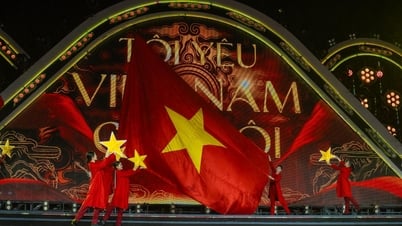









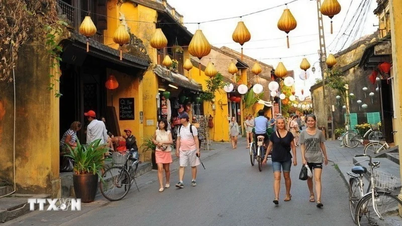

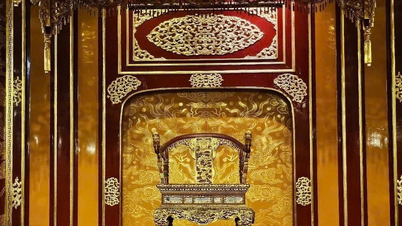
















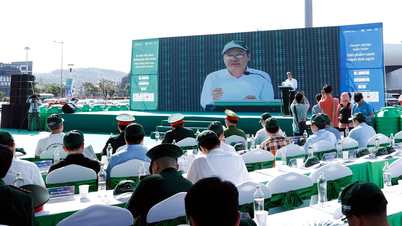
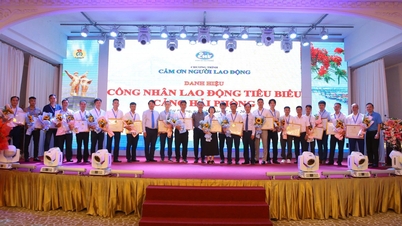












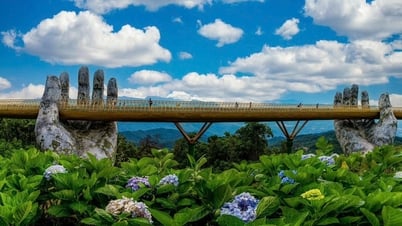
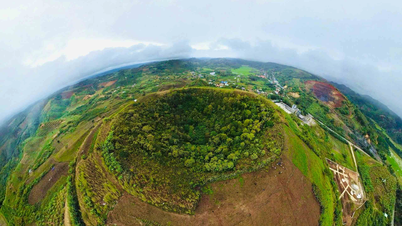




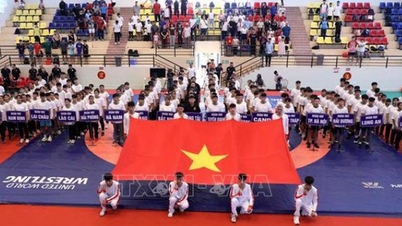
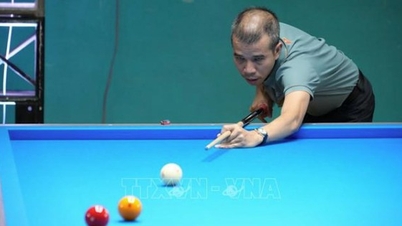
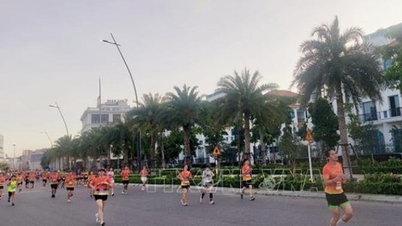
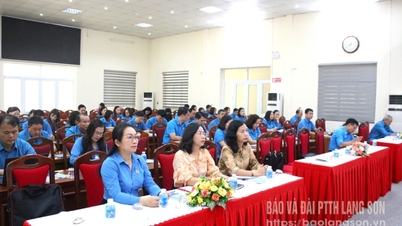

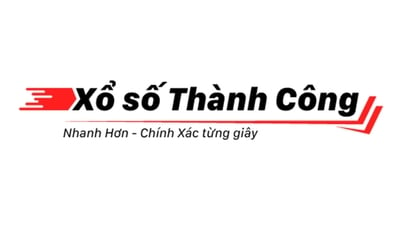




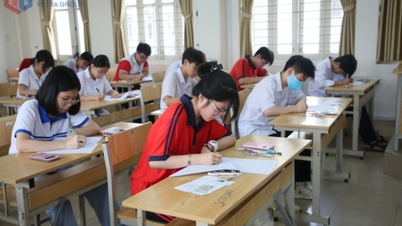













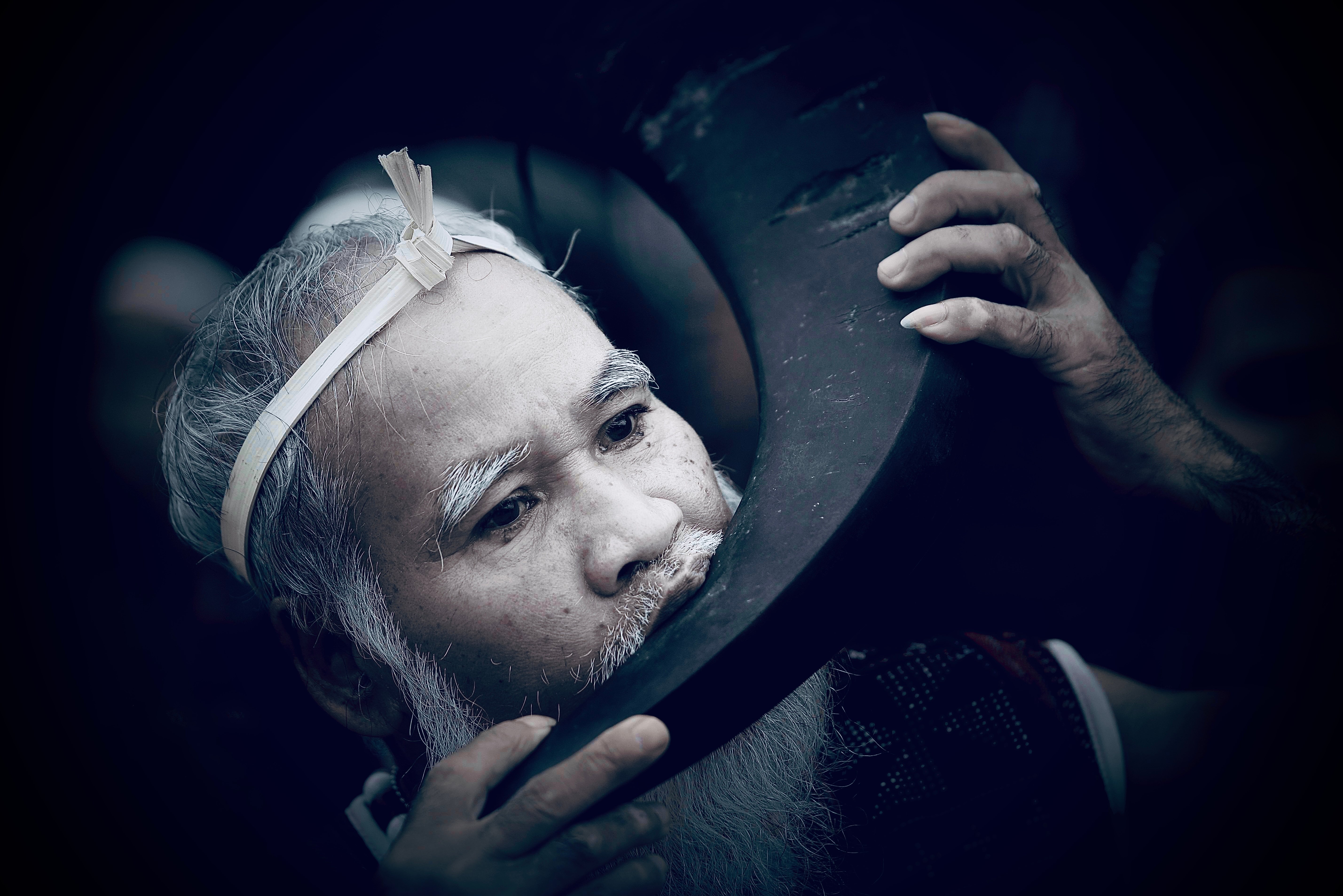


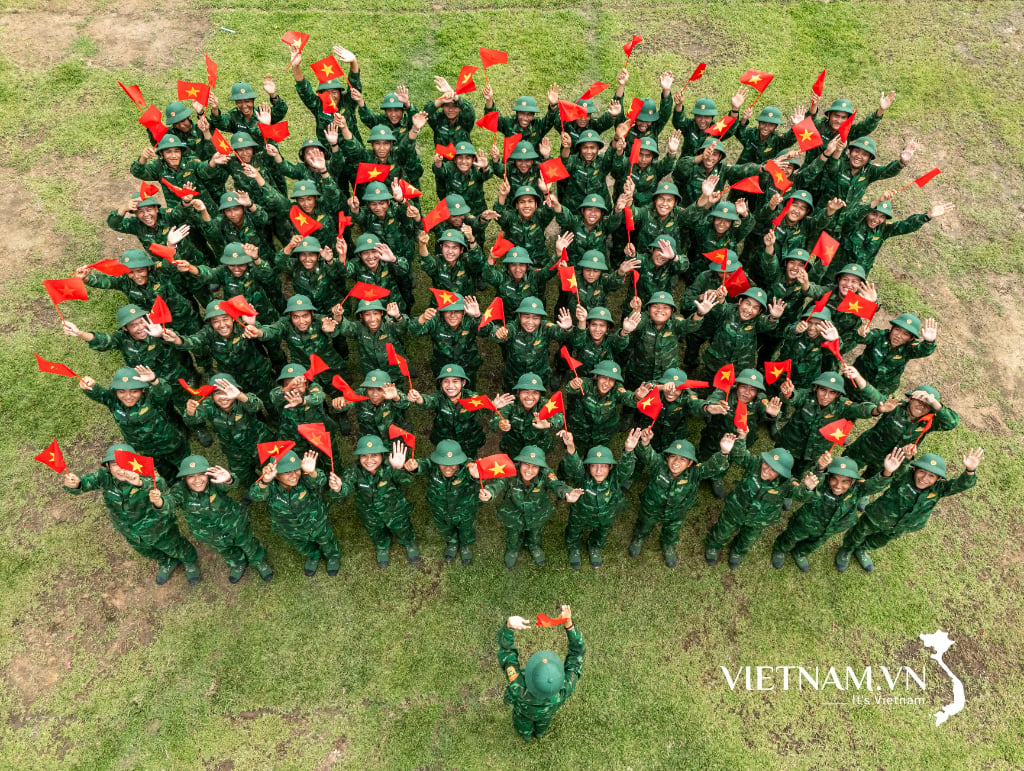
Comment (0)